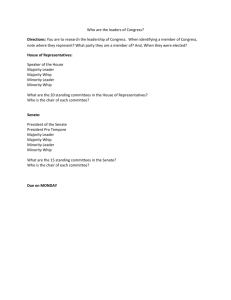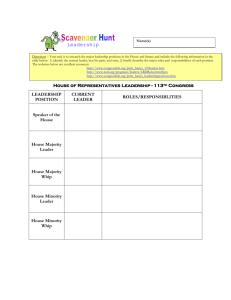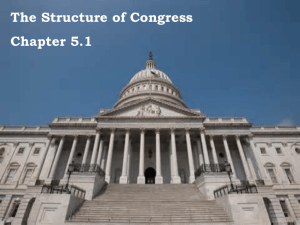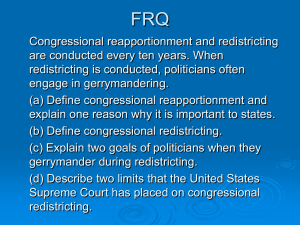US CongRESS - Bama.ua.edu
advertisement
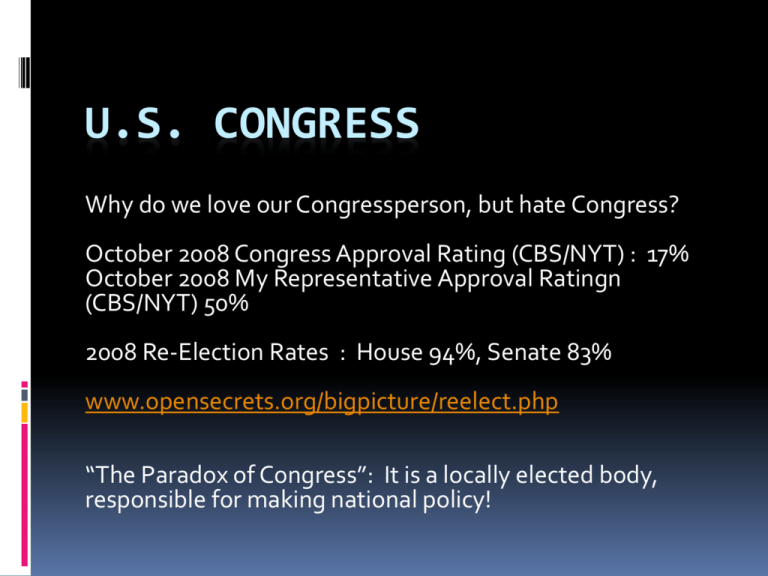
U.S. CONGRESS Why do we love our Congressperson, but hate Congress? October 2008 Congress Approval Rating (CBS/NYT) : 17% October 2008 My Representative Approval Ratingn (CBS/NYT) 50% 2008 Re-Election Rates : House 94%, Senate 83% www.opensecrets.org/bigpicture/reelect.php “The Paradox of Congress”: It is a locally elected body, responsible for making national policy! Bicameralism Original differences between House & Senate: Age, size, basis of representation, term length, method of election (not anymore), size of constituency, Constitutional responsibilities Evolved differences: rules of procedure, level of partisanship, power/function of leadership & committees, power of majority Why the lower and more variable re-election rate for Senators? Longer term, more diverse constituencies, more national visibility, more perceived responsibility, more qualified and better funded challengers Congressional Structure HOUSE Size fixed at 435 Apportionment of Districts (based on census) Who gains? Who loses? Supreme Court and “one person, one vote” Redistricting process – who does it? a.) Partisan gerrymandering LULAC v. Perry, 2006 b.) Racial gerrymandering and MMDs Congressional Structure SENATE Effects of equal representation for each state: state admissions in 19th Century, grant formulas, urban v. rural issues, leadership THE IMPORTANCE OF MAJORITY CONTROL HOUSE PARTIES & LEADERSHIP 1.) House Democratic Caucus -- elects Speaker (Nancy Pelosi), Majority Leader (Steny Hoyer), Majority Whip (James Clyburn) 2.) House Republican Conference – elects Minority Leader (John Boehner), Minority Whip (Eric Cantor) Congressional Structure SENATE PARTIES AND LEADERSHIP Constitutional Leadership: Vice-President (Joseph Biden), President ProTempore (Robert Byrd) Why they did not evolve into the “real” leaders of the Senate 1.) Senate Democratic Conference: elects Majority Leader (Harry Reid), Majority Whip (Dick Durbin) 2.) Senate Republican Conference: elects Minority Leader (Mitch McConnell), Minority Whip (Jon Kyl) Congressional Structure COMMITTEES “Congress in Committee is Congress at Work” Positive and negative power (agendasetting, gatekeeping) Jurisdictions, competition, and multiple referral The Committee Assignment Process: selfselection, seniority, party loyalty How Committee Chairpersons are Selected: committee majority & seniority, caucus approval How a Bill Becomes a Law (or Not) 1.) Introduction and Referral to Committee sponsorship v. cosponsorship 2.) Committee consideration a.) hearings – who testifies? b.) markup session c.) report (noun and verb) 3.) From Committee to the Floor – House House Rules Committee: “gatekeeper to the floor” How a Bill Becomes a Law (or not) 4.) From committee to the floor – Senate The ever-present “filibuster” threat Unanimous consent agreements 5.) House and Senate floor debate & floor amendment process --sneaky ways to “kill” a bill on the floor 6.) How House members and Senators decide to vote: cue-taking, constituency, ideology, and party Representative roles: delegate, trustee, politico National vs. local interest How a Bill Becomes a Law (or Not) 7.) Reconciling House and Senate versions of the same bill: the conference committee 8.) The President’s options – regular veto, pocket veto SAPs and signing statements Why do Members of Congress get re-elected so easily? a.) advertising b.) credit claiming: “pork barrel” projects and “casework” c.) strategic position-taking d.) the financial advantage e.) the “scare-off” effect on potential opponents Is it more important that our congresspersons take the “right” positions, or that they be successful at getting things accomplished? What Americans Don’t Like About Congress John Hibbing and Elizabeth Theiss-Morse Stealth Democracy: Americans' Beliefs About How Government Should Work (Cambridge Univ. Press, 2002) Compromise = Selling Out? Debate=Petty Attack Politics? Does Congress reflect the deep divisions in American society? Morris Fiorina, Culture War? The Myth of a Polarized America

